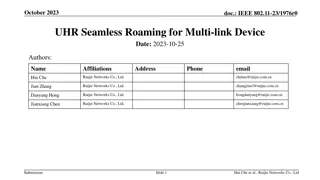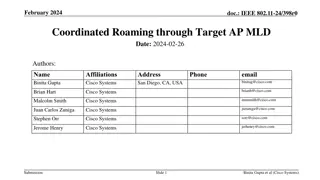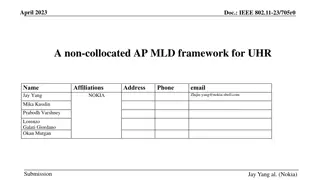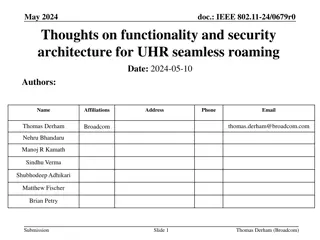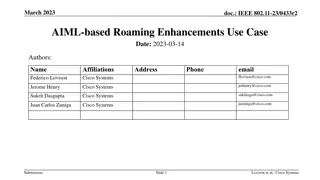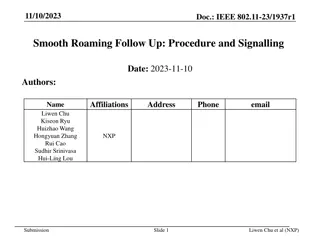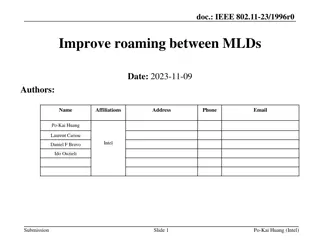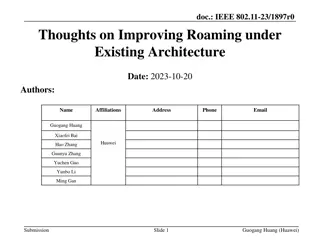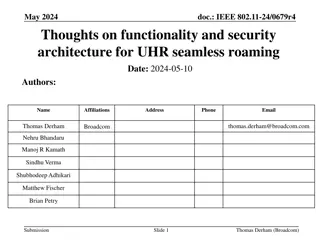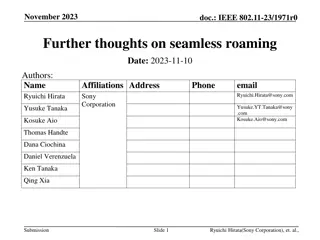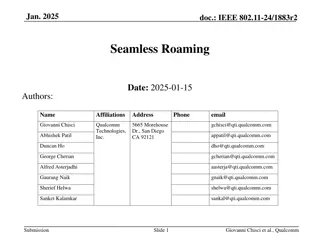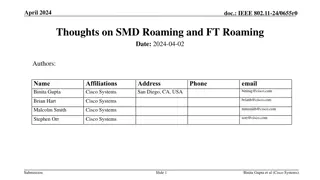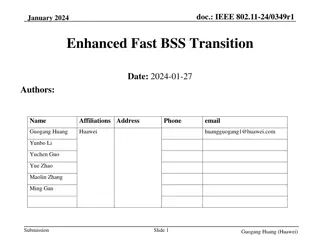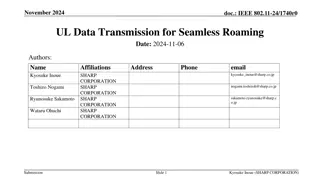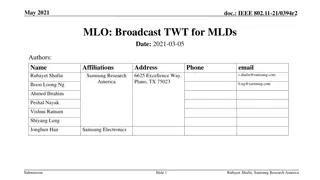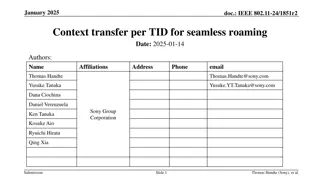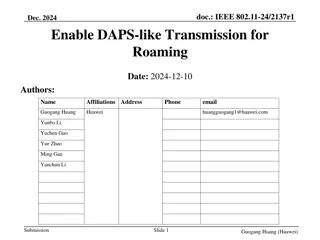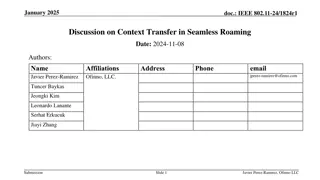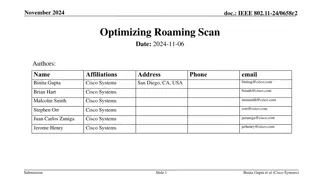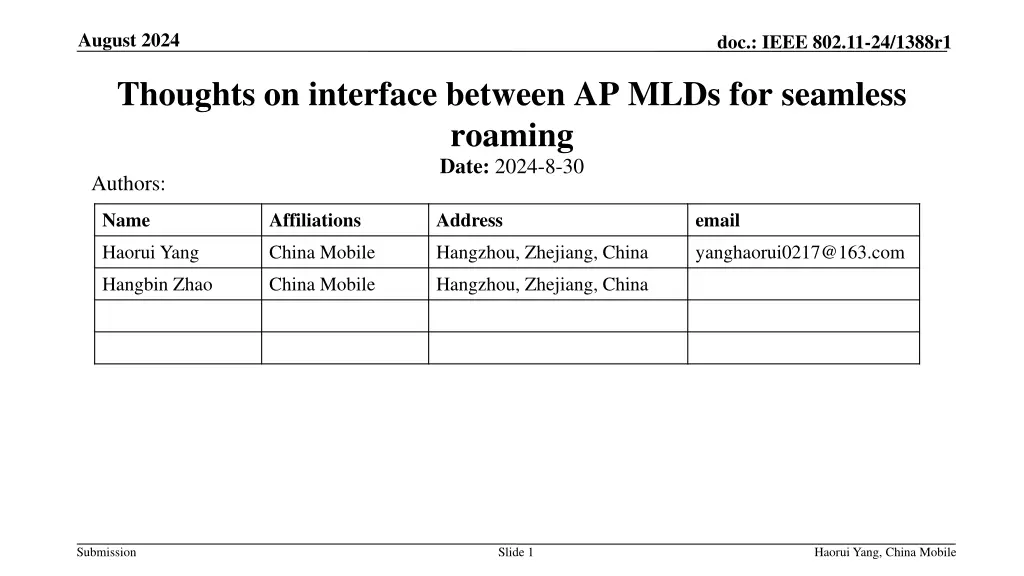
Thoughts on Interface Between AP MLDs for Seamless Roaming
Explore the interface options between AP MLDs for seamless roaming in IEEE 802.11-24/1388r1 document. Discusses over-the-air and over-the-DS interfaces, implications of connecting to different operator networks, and proposes solutions for effective seamless roaming.
Download Presentation

Please find below an Image/Link to download the presentation.
The content on the website is provided AS IS for your information and personal use only. It may not be sold, licensed, or shared on other websites without obtaining consent from the author. If you encounter any issues during the download, it is possible that the publisher has removed the file from their server.
You are allowed to download the files provided on this website for personal or commercial use, subject to the condition that they are used lawfully. All files are the property of their respective owners.
The content on the website is provided AS IS for your information and personal use only. It may not be sold, licensed, or shared on other websites without obtaining consent from the author.
E N D
Presentation Transcript
August 2024 doc.: IEEE 802.11-24/1388r1 Thoughts on interface between AP MLDs for seamless roaming Date: 2024-8-30 Authors: Name Affiliations Address email Haorui Yang China Mobile Hangzhou, Zhejiang, China yanghaorui0217@163.com Hangbin Zhao China Mobile Hangzhou, Zhejiang, China Submission Slide 1 Haorui Yang, China Mobile
August 2024 doc.: IEEE 802.11-24/1388r1 Introduction In [1], it has been agreed that the non-AP MLD context is transferred from the source AP MLD to the target AP MLD; the buffered DL data can be forwarded from the source AP MLD to the target AP MLD. Therefore, the interface protocol between AP MLDs is the base of the seamless roaming procedure. There is the submission that proposes the below options for the interface between AP MLDs: over the air; or over the DS. This submission provides some thoughts on these 2 types of interface in the infrastructure network. Submission Slide 2 Haorui Yang, China Mobile
August 2024 doc.: IEEE 802.11-24/1388r1 Over the DS The over-the-DS interface requests that there is a physical line connecting, directly or indirectly, between the AP MLDs Direct line AP MLDs may connect to the same or different operator networks; Deployment is uncertain and does not depend on the operator; Indirect line over the network Most feasible deployment option; Impossible transmission if the AP MLDs connect to the different operator networks. Both options cannot assume that both AP MLDs connect to the same ESS/operator network. Submission Slide 3 Haorui Yang, China Mobile
August 2024 doc.: IEEE 802.11-24/1388r1 Over the DS Connecting to the different operator network results in the failed seamless roaming and bad performance. There may be the idea that the existing mobility domain concept can be reused to guarantee the AP MLDs belong to the same network, however, it has the below issues: Out of control of the operator since who to control is not specified Operator, AP vendor, user are all possible. Limiting the performance of seamless roaming Mobility domain is a part of ESS which covers a limited area. This makes that the seamless roaming is not an attractive and advanced feature. Submission Slide 4 Haorui Yang, China Mobile
August 2024 doc.: IEEE 802.11-24/1388r1 Over the DS Proposal: The seamless roaming is applied to the AP MLDs connecting to the same operator infrastructure network. The solution to guarantee this is TBD. Submission Slide 5 Haorui Yang, China Mobile
August 2024 doc.: IEEE 802.11-24/1388r1 Over the air The over-the-air interface requests that one AP MLD is inside the service area of another AP MLD, which cannot be always guaranteed. The scenario depends on how to deploy the AP MLDs. Over-the-air interface can be independent from the operator network. Considering the radio capability of AP MLD, it is possible that the AP MLD cannot communicate with each other at the same time with their STAs. Submission Slide 6 Haorui Yang, China Mobile
August 2024 doc.: IEEE 802.11-24/1388r1 Over the air Proposal: The over-the-DS interface should be the default option. The over-the-air interface between AP MLDs should use the dedicated channel to communicate with each other and the transmit power should be controlled to avoid interference. Submission Slide 7 Haorui Yang, China Mobile
August 2024 doc.: IEEE 802.11-24/1388r1 Further thinking It is better to utilize the current infrastructure network as much as possible. The protocol between AP MLDs should be specified in 802.11 to make the deployment of seamless roaming feature more feasible. The protocol can be designed as the payload of data frame in order to minimize the impact to the network behind AP MLD. The network behind AP MLD is out of scope of 802.11, so more dependent less possibility of deployment. Submission Slide 8 Haorui Yang, China Mobile
August 2024 doc.: IEEE 802.11-24/1388r1 Summary This submission provides some thoughts on the 2 options for the interface between AP MLDs: over the DS or over the air. Proposal: The seamless roaming is applied to the AP MLDs under the same operator infrastructure network. The over-the-DS interface between AP MLDs is the default option, considering the over- the-air interface may be impossible. The over-the-air interface between AP MLDs should use the dedicated channel to communicate with each other and the transmit power should be controlled to avoid interference. Submission Slide 9 Haorui Yang, China Mobile
August 2024 doc.: IEEE 802.11-24/1388r1 References [1]: 24/0209r4, Specification Framework for TGbn Submission Slide 10 Haorui Yang, China Mobile

